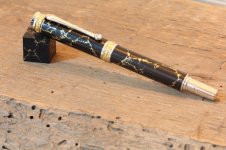Over the years there has been more than one type of trustone. I am not referring to yunstone or other imitators. The first stuff I bought many years ago, I think I remember the term "lapidary grade". Looked a felt like stone. I still have a few pieces. Years later another type appeared which is much easier than the older stuff, but still very hard to turn. Then some other crap came out that seemed no different than alumilite. I cant comment on last years new production.
I also found the common trustone (like the material from beartoothhardwoods). not all are the same difficulty. The white/gold matrix is much easier to turn than the black/gold matrix, for example. I agree, that for the black I switch to carbide.
When I do commissions, and the request is for the best, trustone is my suggestion. In the photo with the blue, that's the old rock. It only came in 5/8" thickness.
View attachment 386005View attachment 386007


![20250716_125909[1].jpg 20250716_125909[1].jpg](https://www.penturners.org/data/attachments/339/339637-f65996a95a72926683de14b85ec892f9.jpg?hash=h4fGC05_WC)